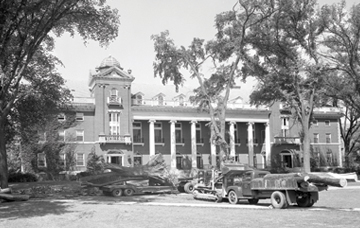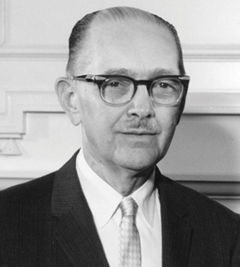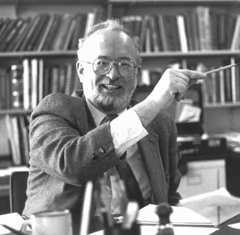Lincoln Hall Project
Illinois at the Crossroads
A Booming Era

(Photos courtesy of University Archives)
The 1950s, 1960s, and early 1970s were a golden age for the University of Illinois. Enrollments boomed, giant building projects were planned and completed, and faculty added academic programs as college was increasingly touted as the ticket to success.
This new era, however, coming on the heels of the duty-bound World War II generation, brought with it contentious new attitudes toward American society and authority. As the Vietnam War heated up, the University struggled to balance the free exchange of ideas with a responsibility to maintain stability and order through some of the most divisive times campus—and the country—had ever seen.
Issues of racial equality, war, military recruiting, business practices, University ties to government, and other student grievances sparked years of unrest. Debates, speeches, rallies, and even violent protest broke out, prompting National Guard troops and riot police to clamp down on campus on more than one occasion.
Keen observers may have sensed it coming. There were certainly signs. During quieter times, in 1957, there appeared a small notice that would have caused uproar 10 or 20 years earlier: The Senior Ball was canceled for lack of interest. It was more than the end of the big band era. It was also a subtle signal that old standards, expectations, rules, and assumptions were about to give way to the new.
Rapidly Building a New Future
Several dorms were built in the late 1950s and early 1960s as the University assumed a larger role in housing students. They included “skyscraper” dormitories such as Florida and Pennsylvania Avenue and Illinois Street residence halls, among others. Several academic buildings were also erected, including Roger Adams Laboratory (1950), Burrill Hall (1959), Morrill Hall (1960), the Psychology Building (1970), and the Foreign Languages Building (1971). In 1963, Assembly Hall, with its 12 million-lb. roof hailed as either an architectural marvel or a disaster waiting to happen, hosted its first men’s basketball game, a victory against Iowa. In 1969, the Krannert Center opened, replacing Lincoln Hall as the center of campus theater.
Bursting Enrollment

Close collaboration between universities and government during World War II lent credibility and relevance to universities such as U of I, and growing enrollments reflected it. Total University enrollments nearly tripled between 1950 and 1970. At Illinois, enrollment grew from 17,000 in 1950 to more than 35,000 in 1970 on the Urbana-Champaign campus alone. The growth was celebrated, but it also caused growing pains, with President David Dodds Henry (above) lamenting in a September 1964 report, “The new academic year opens under the shadow of the grim fact that for the first time in its history, and at a time when the need for educated people is at its greatest, the University of Illinois has denied enrollment to several thousand qualified students.”
Continuing Advances in Research

Research and class offerings expanded as the campus grew. In 1961, anthropologist Oscar Lewis published Children of Sanchez, an examination of poverty that gained worldwide attention. Biologist Arthur DeVries discovered “fish antifreeze” in 1964, explaining how fish could survive Antarctic waters. The study of entomology expanded greatly on campus during this era. In 1968, the University opened Prairie Observatory near Oakland, Ill., with a 40-inch telescopic lens. In 1969, African American studies originated on campus, and in 1970 the University offered its first course in women’s studies. And it was during this era that chemist and Nobel Laureate Paul Lauterbur (above) pioneered discoveries that made possible magnetic resonance imaging (MRI).